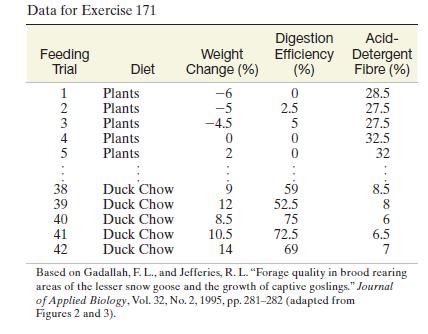171 Snow geese feeding trial. The Journal of Applied Ecology (Vol. 32, 1995) performed a study of...
Question:
171 Snow geese feeding trial. The Journal of Applied Ecology
(Vol. 32, 1995) performed a study of the feeding habits of baby snow geese. Data on gosling weight change, digestion efficiency, acid-detergent fiber (all measured as percentages), and diet (plants or duck chow) for 42 feeding trials are saved in the SNOWGEESE file. Selected observations are shown in the table. The botanists were interested in predicting weight change ( y ) as a function of the other variables. Consider the first-order model E(y) = b0 + b1x1 + B2x2, where x1 is digestion efficiency and x2 is acid-detergent fiber.
a. Find the least squares prediction equation for weight change y .
b. Interpret the b@estimates in the equation you found in part a .
c. Conduct a test to determine whether digestion efficiency, x1, is a useful linear predictor of weight change.
Use a = .01.
d. Form a 99% confidence interval for b2. Interpret the result.

e. Find and interpret R2 and R2a . Which statistic is the preferred measure of model fit? Explain.
f. Is the overall model statistically useful in predicting weight change? Test, using a = .05.
g. Write a first-order model relating gosling weight change ( y ) to digestion efficiency (x1) and diet (plants or duck chow) that allows for different slopes for each diet.
h. Fit the model you wrote in part g to the data saved in the SNOWGEESE trial. Give the least squares prediction equation.
i. Refer to part g . Find the estimated slope of the line for goslings fed a diet of plants. Interpret its value.
j. Refer to part g . Find the estimated slope of the line for goslings fed a diet of duck chow. Interpret its value.
k. Refer to part g . Conduct a test to determine whether the slopes associated with the two diets are significantly different. Use a = .05.
Step by Step Answer:







